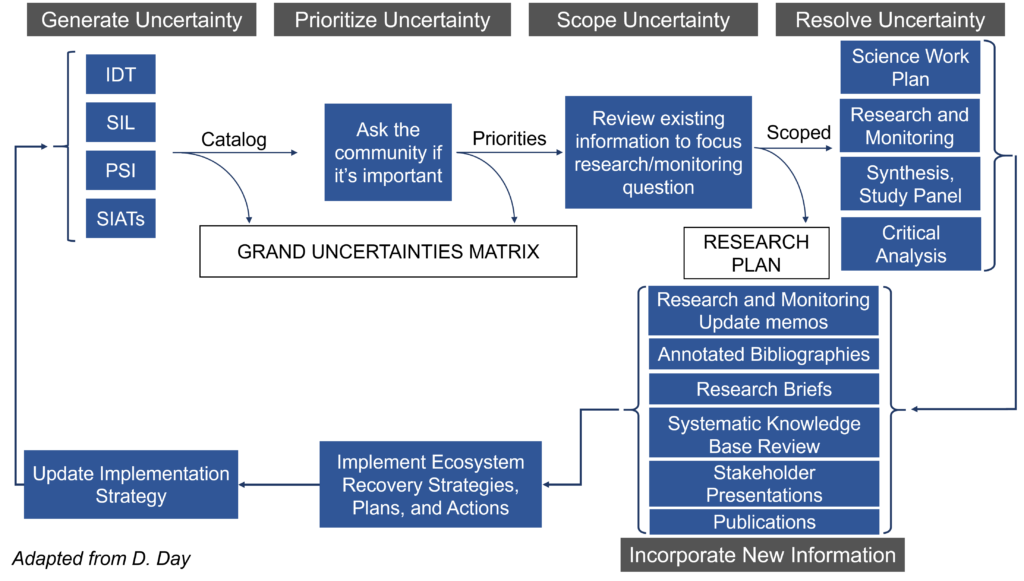Planning and implementing regional ecosystem recovery activities relies on an understanding of causal relationships between an action (such as estuary restoration) and an outcome (improved juvenile salmon survival) that is based on experience, observation, and research. Remaining gaps (“uncertainties”) in our knowledge of these relationships can reduce the effectiveness of recovery. To address these gaps, we work with National Estuary Program partners to develop a research agenda that is focused on the ecosystem management and restoration topics included in Puget Sound management plans (Implementation Strategies). We engage directly with Implementation Strategy development teams and other experts and stakeholder groups to identify and prioritize uncertainties that impact the ability to plan and/or implement recovery activities. The result is a codeveloped research agenda that informs the Puget Sound Partnership’s Science Work Plan, Strategic Initiative Lead funding decisions, and the selection of PSI Critical Analysis projects.
Grand Uncertainties Matrix (GUM) Infographic: Dorning, S., Evrard, R., Kinney, A., James, C. A. (2025). Puget Sound’s Grand Uncertainties Matrix research agenda co-development (pdf). University of Washington Puget Sound Institute.
Toxics Research Agenda Fact Sheet: Dorning, S., Evrard, R., James, C. A. (2025). Scientific research priorities about toxics in Puget Sound (pdf). University of Washington Puget Sound Institute.
Shellfish Research Agenda Fact Sheet: Evrard, R., Dorning, S., James, C. A. (2025). Scientific research priorities for shellfish in Puget Sound (pdf). University of Washington Puget Sound Institute.
How do we address uncertainties?
We use an adaptive process that involves identifying knowledge gaps or uncertainties, prioritizing the most important ones, addressing those priorities, and then feeding new knowledge about uncertainties back into recovery planning, implementation, and decision-making. This process supports the adaptive management of Puget Sound Implementation Strategies. Our process for curating and addressing uncertainties involves the steps described below (and in an infographic) and is illustrated in the following diagram.

Step 1: Generate
We collate uncertainties that limit understanding of problems and potential solutions related to regional recovery targets. These uncertainties are generated during the development of Implementation Strategies and other recovery plans, during program implementation, and from other relevant sources such as workshops and symposia.
Step 2: Prioritize
We engage regional expert/stakeholder groups to prioritize uncertainties based on their importance to the development or operationalization of an Implementation Strategy.
Step 3: Scope research
We then work with partners to scope out a research project, to provide enough background and detail that a Request for Proposals or research project can be developed to address an uncertainty.
Step 4: Resolve
Specific uncertainties can be, and are, addressed by a wide range of recovery partners throughout the region. This also includes research projects by PSI called Critical Analyses.
Step 5: Incorporate new information
We then synthesize new information about uncertainties in various formats for communication to managers of Implementation Strategies. The goal is that such information can be used to improve planning and make better decisions.
The Grand Uncertainties Matrix (GUM)

In 2018, we developed the Grand Uncertainties Matrix (GUM) to catalog and document the progress and results of the processes to identify, prioritize, and address scientific uncertainties. Key information that we curate in the GUM includes: 1) a catalog of relevant uncertainties from Implementation Strategies, 2) the status and results of any prioritization processes to date, and 3) brief descriptions of relevant research that might address uncertainties. This living document is designed to further the work of developing a focused research agenda, incorporating scientific research into planning and decision making, and supporting adaptive management in Puget Sound.
Access the GUM on the Encyclopedia of Puget Sound and learn more about it in our GUM infographic and in this interview with Tessa Francis.
GUM Documents
In addition to recording uncertainties in the GUM we also produce:
- Reports describing our specific efforts to generate and prioritize uncertainties
- Fact sheets highlighting the top priority uncertainties for a given topic area (Implementation Strategy)
- Research briefs synthesizing new scientific research (including but not limited to PSI’s Critical Analysis research projects) about uncertainties.
GUM documents are organized below according to topic (Implementation Strategy).
For the top research priorities identified in 2024/2025, read the following fact sheet:
Evrard, R., Dorning, S., James, C. A. (2025). Scientific research priorities for shellfish in Puget Sound (pdf). University of Washington Puget Sound Institute.
For information about our 2024/2025 effort to generate and prioritize uncertainties to update the Puget Sound Shellfish Beds research agenda, read:
Evrard, R., Kanojia, M., James, C. A., & Dorning, S. (2025). Developing a research agenda for the Shellfish Beds Implementation Strategy (pdf). University of Washington Puget Sound Institute.
For the top research priorities identified in 2024/2025, read the following fact sheet:
Dorning, S., Evrard, R., James, C. A. (2025). Scientific research priorities about toxics in Puget Sound (pdf). University of Washington Puget Sound Institute.
For information about our 2024/2025 effort to generate and prioritize uncertainties to update the Puget Sound toxics research agenda, read:
Dorning, S., Kanojia, M., & James, C. A. (2025). Toxics in Aquatic Life Implementation Strategy research agenda update 2024/2025 (pdf). University of Washington Puget Sound Institute.
For information specifically about the microplastics research agenda, read:
Dorning, S., Kanojia, M., & James, C. A. (2025). Toxics in Aquatic Life Implementation Strategy research agenda update 2024/2025: Microplastics (pdf). University of Washington Puget Sound Institute.
Contact
Sandra Dorning (sdorning @ uw.edu)
PSI contributors
Sandra Dorning
Raye Evrard
Andy James
Aimee Kinney
Caitlin Magel
Stefano Mazzilli
Chris Wally Wright
Partner organizations
Puget Sound Partnership
Habitat Strategic Initiative Lead
Shellfish Strategic Initiative Lead
Stormwater Strategic Initiative Lead
Oregon State University Human Dimensions Lab
